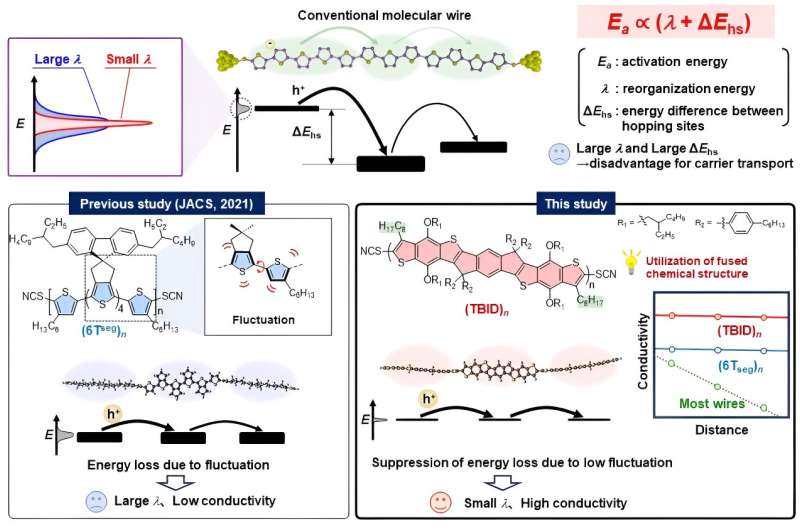This article has been reviewed according to Science X's editorial process and policies. Editors have highlighted the following attributes while ensuring the content's credibility:
fact-checked
peer-reviewed publication
trusted source
proofread
Twisted molecular wires exhibit high single-molecule conductance

From the high-voltage wires that carry electricity over long distances, to the tungsten filaments in our incandescent lights, we may have become accustomed to thinking that electrical conductors are always made of metal. But for decades, scientists have been working on advanced materials based on carbon-based oligomer chains that can also conduct electricity. These include the organic light-emitting devices found in some modern smartphones and computers.
In quantum mechanics, electrons are not just point particles with definite positions, but rather can become 'delocalized' over a region. A molecule with a long stretch of alternating single- and double-bonds is said to have pi-conjugation, and conductive polymers operate by allowing delocalized electrons to hop between pi-conjugated regions—somewhat like a frog hopping between nearby puddles.
However, the efficiency of this process is limited by differences in the energy levels of adjacent regions. Fabricating oligomers and polymers with more uniform energy levels can lead to higher electrical conductivity, which is necessary for the development of new practical organic electronics, or even single-molecule wires.
Now, in a study published in The Journal of the American Chemical Society, researchers from SANKEN (The Institute of Scientific and Industrial Research), at Osaka University have created several nanometer-scale molecular wires with periodic twists.
Compared with previous attempts that used one long chain that could rotate randomly, these oligomers consisted of rigid fused regions separated by evenly spaced twists. The researchers showed that their samples exhibited higher conductance compared with that found in non-fused oligothiophenes.
"By carefully controlling the size of these pi-conjugated regions, high single-molecule conductance was achieved in these oligomers using rigid molecular structures," says Ryo Asakawa, lead author of the study.
The researchers hope that this method can be applied to fabricate new organic electronic devices, which can be made more cheaply as thin chemical films applied to flexible substrates, compared with conventional silicon-based methods, which often require special clean rooms to produce using lithography.
"We expect this research will lead to better single-molecule electronics and organic thin-film devices," says senior author Yutaka Ie. Individual molecular wires might even be used as biocompatible sensors inside living cells.
More information: Ryo Asakawa et al, Periodically Twisted Molecular Wires Based on a Fused Unit for Efficient Intramolecular Hopping Transport, Journal of the American Chemical Society (2024). DOI: 10.1021/jacs.4c07548
Journal information: Journal of the American Chemical Society
Provided by Osaka University





















